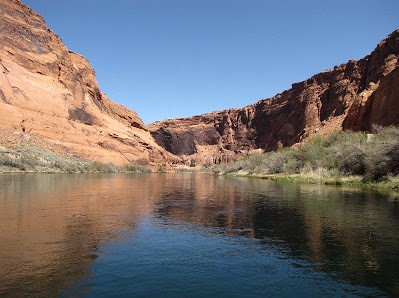According to my last post, I’ve been to the Burgess Shale twice and on one of those treks volunteered as a guide on hikes to the Walcott Quarry and Mt. Stephen fossil beds. I’ve hiked on the Athabasca Glacier – across barely a miniscule square-mile area of a San Francisco-sized chunk of Rocky Mountain ice, but it was a glacier nevertheless. I’ve backpacked in Katmai National Park to Novarupta, the 1912 site of the world’s largest volcanic eruption of the 20th century. What’s the next item on my Geological Bucket List? I have been warned that as long as I don’t use the word “uber” anymore, there are quite a few possibilities.
First things first. I’ve really got to experience more of my own geological backyard before venturing any further. Ninety miles away from where I live there exists this really big hole in the ground with a river running through it that begs for my attention. I’ve hiked on the rim and backpacked down into Grand Canyon but have never floated through it on the Colorado River.
Wait a minute! exclaims MY TRAVEL AGENT innocently. Don’t I want to float the entire river? He could arrange for that, he says nonchalantly, from the source at swampy La Poudre Pass Lake high on the continental divide in Colorado, all the way to some vague location past the Salton Sink and the desiccated wasteland that is the 21st century’s mouth of the mighty river. He’d route me to find Mexico and the Sea of Cortez somehow. Wouldn’t I want to do the whole enchilada?
Colorado River below Glen Canyon Dam
Mmmm… Probably not. Too many logistics. Running the Colorado River in Grand Canyon National Park is what I’ve had in mind for a long time. My GBL trip would be a 14-day hybrid oar-and-paddle trip for the distance of 226 river miles from Lee’s Ferry below Glen Canyon Dam to Diamond Creek above Lake Mead. I want to savor floating serenely and paddling manically through geologic time, through nearly two billion years of Earth history, down, down, down into the crystalline basement rocks of narrow Granite Gorge of the Inner Canyon, into rocks that are first cousins to schists and gneisses found in the Beaver Dam Mountains of southwestern Utah.
For now, I’d like to think I’m not finished in Canada – one totally accessible target on my GBL is Cape Breton Highlands National Park in Nova Scotia. Its Cape Breton Plateau plastered across the northeastern tip of this Maritime Province could surely make me weep tears of ecstasy – they are the exposed roots of the Appalachian Mountains, formed 360-325 million years ago during tectonic collisions between ancient Europe and North America.
However, one big-dream GBL entry may be more dream than reality since what I have in mind would be monumentally more difficult to attain than rafting Grand Canyon and would cost even more buckets-full of cash. Some of the oldest intact rock units on the planet can be found in Canada and here lies my big-dream GBL. To get to the Acasta Gneiss (4.03 billion years or so old) I merely have to get to Yellowknife in the Northwest Territories (Salt Lake City to Calgary to Yellowknife – I have looked into this!), then charter a bush pilot to take me 300 km north onto the Slave Craton near Great Bear Lake, and then find a certain obscure island in the middle of the obscure Acasta River…
Nothing can keep me from my dreams.
These are only a few entries on my Geological Bucket List. Leave a comment and let me know of yours!






